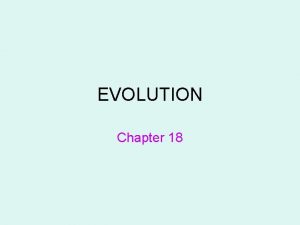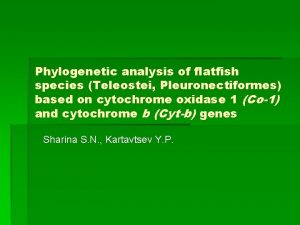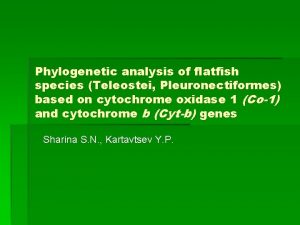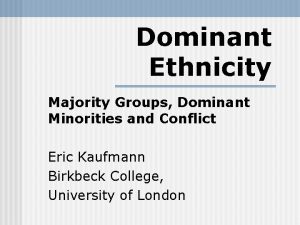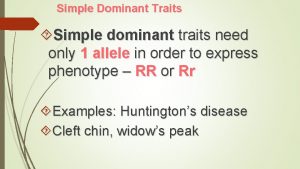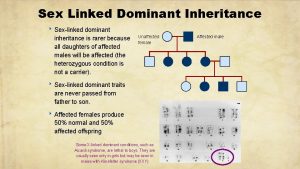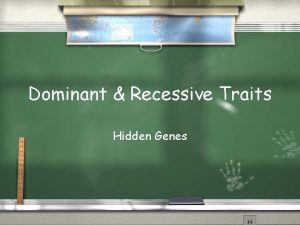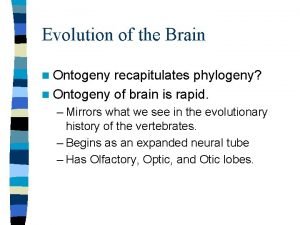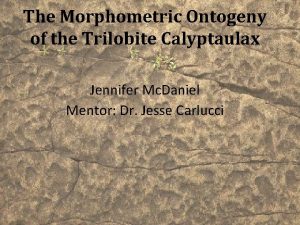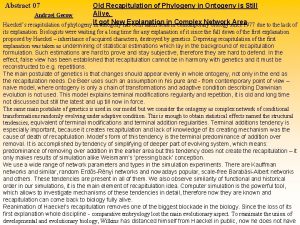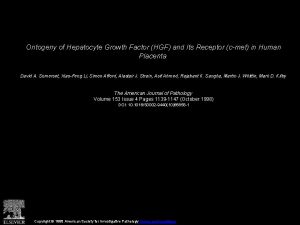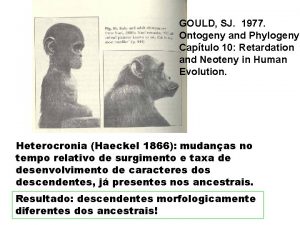TRENDS ON THE ONTOGENY OF THE DOMINANT FLATFISH


















- Slides: 18

TRENDS ON THE ONTOGENY OF THE DOMINANT FLATFISH SPECIES ON THE SOUTHERN BAY OF BISCAY: ECOLOGY AND DISTRIBUTION PATTERNS O. Fernández-Zapico*, A. Punzón, A. Serrano, J. Landa, S. Ruiz-Pico and F. Velasco. Instituto Español de Oceanografía, Centro Oceanográfico de Santander Promontorio de San Martín s/n, 39004. Santander, Spain.

OUTLINE • INTRODUCTION • AIM • METHODS 1. Study area 2. Data source 3. Data analysis • RESULTS • DISCUSSION & CONCLUSIONS

INTRODUCTION Ecological IMPORTANCE benthos feeders Economical Intermediaries E transfer Bottom quality indicators Distribution commercial flatfish PREVIOUS STUDIES (eg. Sánchez et al. , 1998, Sánchez et al. , 2001, Gerritsen et al. , 2010) Environmental drivers in communities distribution (eg. Sullivan et al. , 2000, Serrano et al. , 2008) GAP OF KNOWLEDGE • Pleuronectiformes order distribution • Ontogeny • Leading factors

AIM Analyze the population of the order Pleuronectiformes in the Northern Spanish shelf 1 describing its distribution in the area, 2 establishing the leading factors that drive it. 3 observing the ontogeny in that distribution.

METHODS 1. Study area Time-series from 2002 to 2011 Sampling strategy

METHODS 2. Data source Biological data Explanatory variables • Latitude • Longitude • Depth (m) Sieving & sedimentation Combustion • Median particle diameter (Q 50, µm) • Organic matter (%) • Sorting coeficient (S 0) • T (ºC) • S (‰)

METHODS 3. Data analysis: Species and length categories Boscii_s 3 -17 cm Boscii_m 18 -25 cm Boscii_l 26 -44 cm Arnoglossus imperialis Imperialis_s: 6 -12 cm; Imperialis_l: 13 -20 cm Buglossidium luteum Lepidorhombus boscii Buglossidium_s: 7 -11 cm; Buglossidium_l: 12 -15 cm Whiffi_s: 5 -20 cm Whiffi_m: 21 -29 cm Whiffi_l: 30 -53 cm Arnoglossus laterna Laterna_s: 2 -10 cm; Laterna_l: 11 -18 cm Bathysolea profundicola Microchirus variegatus L. whiffiagonis Microchirus_s: 4 -12 cm; Microchirus_l: 13 -24 cm Pegusa lascaris Bathysolea_s: 10 -17 cm; Bathysolea_l: 18 -23 cm Lascaris_s: 19 -23 cm; Lascaris_l: 24 -37 cm Solea solea Solea_s 11 -27 cm Solea_m 28 -39 cm Solea_l 40 -50 cm

METHODS CLUSTER ANALYSIS MANOVA Associations among species and size groups Significance of e. variables in the spp composition Canonical Correspondance Analysis (CCA) Centers of Gravity (Co. G) 3. Data analysis: statistics Ordered structure spp and e. variables Mean value of the variable analized weighted to the abundance of the species in the haul i mean value of the environmental variable given

SB IS M-OS RESULTS CLUSTER ANALYSIS 3 main assemblages Inner shelf group (IS) P. lascaris, B. luteum, S. solea Medium and outer shelf group (M-OS) A. laterna, A. imperialis, M. variegatus, L. whiffiagonis, L. boscii Shelf break and upper slope group (SB) B. profundicola.

RESULTS MANOVA: Importance of Explanatory variables

RESULTS CCA: Biological vs. Explanatory data

P. lascaris B. luteum RESULTS FLATFISH DISTRIBUTION WITH DEPTH (Co. G) S. solea A. imperialis A. laterna M. variegatus L. whiffiagonis L. boscii B. profundicola (Co. G)

RESULTS FLATFISH DISTRIBUTION WITH SEDIMENT SIZE (Co. G) Median particle diameter 125 -250 µm-> “Fine sands” 250 -500 µm-> “Middle sands” 500 -1000 µm-> “Coarse sands”

FLATFISH DISTRIBUTION WITH LONGITUDE AND LATITUDE (Co. G) RESULTS B. profundicola A. imperialis M. variegatus A. laterna L. whiffiagonis P. lascaris L. b c os ii S. solea B. luteum

DISCUSSION & CONCLUSIONS Bathymetric segregation Interespecies Diet composition Strategy: Resource partitioning Avoid interspecific competition (Piet, 1998) Depth Ontogeny (intra + -species) - (Sánchez, 1993) 6/9 spp 3/9 spp 1. Depth has been revealed as the main factor in structuring flatfish distribution. **previous papers have explained the bathymetric segregation as a strategy of resource partitioning & avoiding inter-specific competition, on the basis of their diet. 2. A positive pattern between ontogeny and depth in 6/9 spp analyzed was found. **this pattern has been confirmed for several flatfish species in other areas.

DISCUSSION & CONCLUSIONS Fine sands 8/9 spp Inter-species A. imperialis Coarse sands Ability to bury f (spp & sizes) Sediment size (Stoner & Ottmar, 2003) Ontogeny (intra-species) + 6/9 spp sediment choice (Gibson, 2014) - 3/9 spp Avoid predation 3. Sediment size has been revealed as the second factor in structuring flatfish distribution. **Avoiding predation and feeding is considered the main reason for association with sediment; previous studies have related sediment choice with the ability to bury in it as a function of the species and size. 4. A positive pattern has been found between ontogeny and sediment size in 6/9 spp analysed.

DISCUSSION & CONCLUSIONS W Interespecies Longitude & Latitude Ontogeny (intraspecies) L. boscii A. laterna E L. whiffiagonis A. imperialis No ontogenetic changes, but trend Fishing mortality? 5. Longitude and Latitude are also important factors in structuring flatfish distribution. 6. These variables differenciate species into the genus Arnoglossus and Lepidorhombus, probably as a consequence of the sediment they are associated. 7. They don’t seem to show ontogenetic changes in relation to latitude and longitude, but they follow a trend, with higher abundance of larger individuals towards the east, maybe as a consequence of a stronger fishing effort in the western area.

Thanks for your attention
 Ontogeny recapitulates phylogeny
Ontogeny recapitulates phylogeny đặc điểm cơ thể của người tối cổ
đặc điểm cơ thể của người tối cổ Tỉ lệ cơ thể trẻ em
Tỉ lệ cơ thể trẻ em Các châu lục và đại dương trên thế giới
Các châu lục và đại dương trên thế giới ưu thế lai là gì
ưu thế lai là gì Thẻ vin
Thẻ vin Kể tên các môn thể thao
Kể tên các môn thể thao Tư thế ngồi viết
Tư thế ngồi viết Cái miệng nó xinh thế chỉ nói điều hay thôi
Cái miệng nó xinh thế chỉ nói điều hay thôi Hát kết hợp bộ gõ cơ thể
Hát kết hợp bộ gõ cơ thể Từ ngữ thể hiện lòng nhân hậu
Từ ngữ thể hiện lòng nhân hậu Trời xanh đây là của chúng ta thể thơ
Trời xanh đây là của chúng ta thể thơ Tư thế ngồi viết
Tư thế ngồi viết Thế nào là giọng cùng tên?
Thế nào là giọng cùng tên? Gấu đi như thế nào
Gấu đi như thế nào Thể thơ truyền thống
Thể thơ truyền thống Hươu thường đẻ mỗi lứa mấy con
Hươu thường đẻ mỗi lứa mấy con Thế nào là hệ số cao nhất
Thế nào là hệ số cao nhất Diễn thế sinh thái là
Diễn thế sinh thái là
